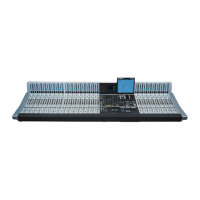D950/Vista Digital Mixing System
Date printed: 05.08.03 SW V3.3 GC Operation 4-13
4.3.3 Labels
Labels are used extensively within the system to define objects, such as
audio sources, channel names, etc., and to visualize these objects in vari-
ous windows within the GC.
Please note that all labels are stored within Snapshots and Presets, together
with all audio settings.
There are various ways to work with labels within the system. For a de-
scription of how to use labels, refer to chapter 4.4.2.6. Basic label types
are described below:
Fixed Labels These are generated automatically at the time of system configuration, and
used to identify hardware-oriented objects. For example:
Fixed Label Meaning
D 1 AES B0 In 1
Digital AES/EBU, on PE/AES Board 0, Physical Input 1
Input m 8 In 1
DSP Mono Input Channel 8, Input 1 of 3
M25 B0 Out 1CH25
MADI Output CH 25, on MADI B 0, MADI Interface 1
Note: It is advised never to change the Fixed Labels.
User Labels These by default are identical to the Fixed Labels at the start of a new Ses-
sion Configuration. The user is able to rename these User labels in the GC
to make the system environment more user friendly. User labels are used
to give the objects a useful, application-oriented name. For example:
Fixed Label User Label Meaning
D 1 AES B0 In 1
DAT 1
DAT Player 1, coming in via Digital AES/EBU, on
PE/AES Board 0, Physical Input #1
Input m 8 In 1
BASS
DSP Mono Input Channel 8, Input 1 of 3, used for
the audio signal of the Bass Guitar
M25 B0 Out 1CH25
Foldback 1
MADI Output CH 25, on MADI B 0, MADI Interface
1, is the foldback Send 1 to the Studio Floor
Inherited Labels Inherited labels are used primarily to indicate the Source Signal that is
connected to the Channel Strip, rather than the User Label of the Channel.
In this way, as soon as the signal is connected to a channel’s input, the
channel strip display inherits the Label from the actual Source.

